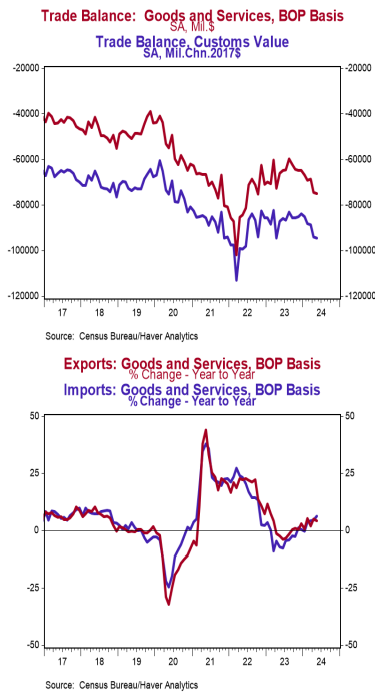- The trade deficit in goods and services came in at $75.1 billion in May, smaller than the consensus expected $76.5 billion.
- Exports fell by $1.8 billion, led by civilian aircraft, nonmonetary gold, other petroleum products and fuel oil. Imports declined by $1.2 billion, led by pharmaceuticals, autos, and civilian aircraft.
- In the last year, exports are up 4.3% while imports are up 6.2%.
- Compared to a year ago, the monthly trade deficit is $9.0 billion larger; after adjusting for inflation, the “real” trade deficit in goods is $7.5 billion larger than a year ago. The “real” change is the trade indicator most important for measuring real GDP.
Implications: The trade deficit in goods and services grew to $75.1 billion in May as exports fell by more than imports. However, we prefer to focus on the total volume of trade, imports plus exports, as it shows the extent of business and consumer interaction across the US border. This measure fell in May, declining by $3.0 billion, although total trade volume is up 5.4% from a year ago, with exports up 4.3% and imports up 6.2%. Notably, there is a major shift going on in the pattern of US trade. Through the first five months of the year, imports from China were down 2.5% versus the same period in 2023 and down 26.3% versus the same period in 2022. China used to be the top exporter to the US. Now the top spot is held by Mexico; China has fallen to number three with Canada now in second place. Meanwhile, global supply chain pressures have eased substantially over the past few years. This was confirmed by the New York Fed’s Global Supply Chain Pressure Index in May, with the index -0.48 standard deviations below the index’s historical average. For some perspective, two years ago in the month of May the index sat 2.71 standard deviations above the index’s historical average. Expect some temporary volatility though as Yemen’s Houthi rebels continue to deter container ships from transiting the Red Sea and Bab-el-Mandeb Strait, adding volatility to shipping costs. Also in today’s report, the dollar value of US petroleum exports exceeded imports once again. This marks the 24th consecutive month of the US being a net exporter of petroleum products. In other news today, initial unemployment claims rose 4,000 last week to 238,000. Continuing claims increased 26,000 to 1.858 million. Also on the employment front, ADP’s measure of private payrolls increased 150,000 in June versus a consensus expected 165,000. Plugging this into our models finalizes our forecast for the official nonfarm payroll report for June (to be announced Friday morning) at 194,000. Expect payroll growth to slow down further in the months ahead. In other recent news, cars and light trucks were sold at a 15.3 million annual rate in June, down 4.0% from May and 4.8% lower than a year ago. Expect a bounce back in sales in July as dealerships get past problems related to cyberattacks.





